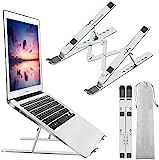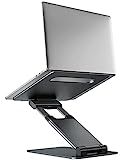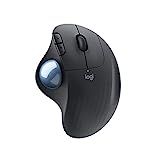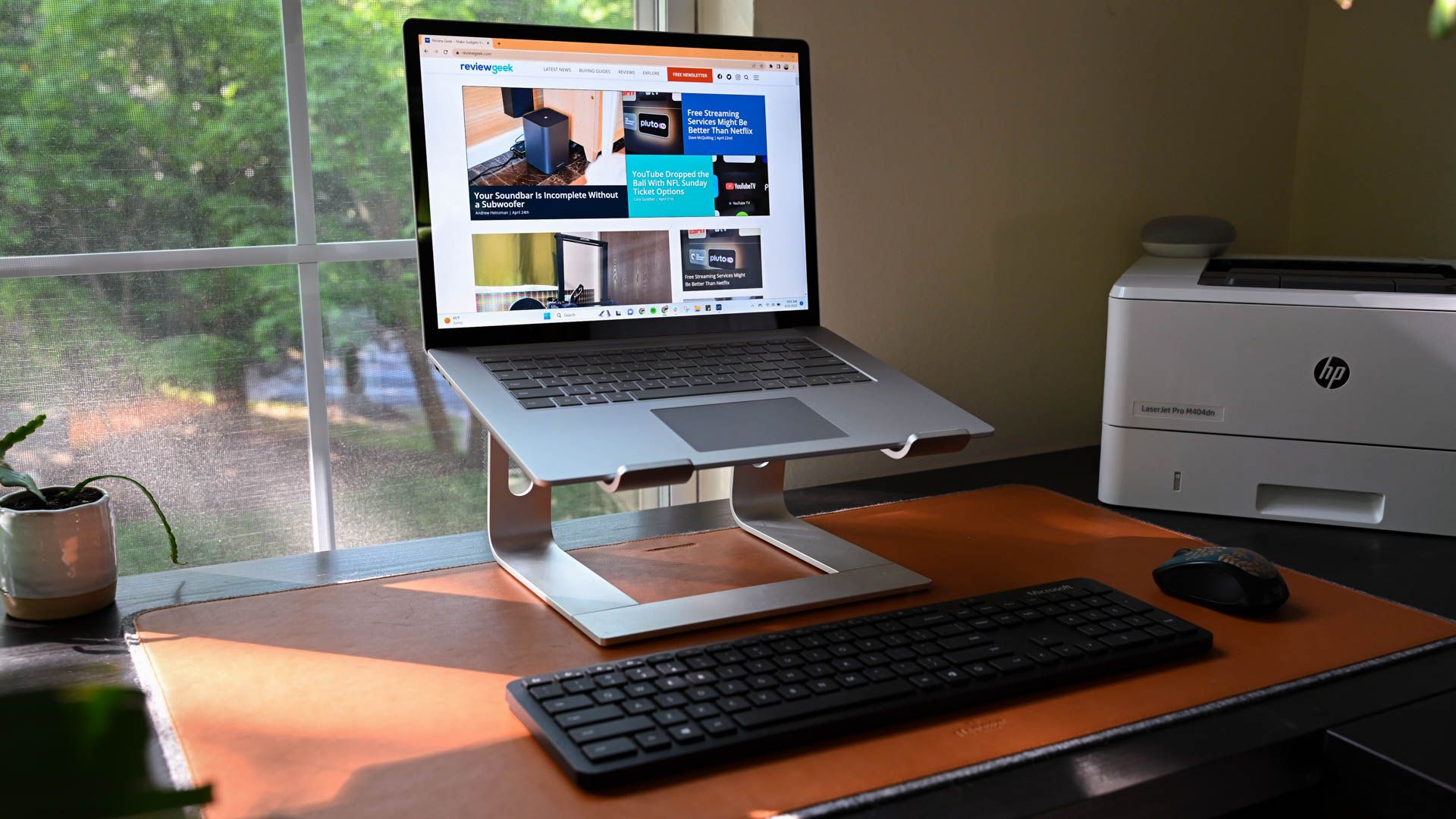Quick Links
Laptops are many things---convenient, portable, and increasingly powerful with each new generation. But one thing they certainly aren't is ergonomic and kind to your body. Here's how to enjoy your laptop pain-free in only three steps.
Why Are Laptops So Hard on Your Body?
To look at why laptops are tough on our bodies, let's start by describing what an ergonomically ideal workstation looks like for most people.
Ideally, you are seated with your feet flat on the floor or a footrest such that your knees are level with your hips or slightly below. Your back is well supported with a slight recline. Your keyboard and mouse are on a desk surface or tray, allowing you to keep your elbows at a 90-degree angle.
Your wrists are flat or, with the tray, even draped down slightly at a negative incline. The computer screen is about an arm's length away and elevated so that, with your neck and shoulders relaxed in a neutral position, your eye level is right about at the top of the monitor, give or take a few inches.
All of that sounds nothing like what using a laptop looks like. When using a laptop on your lap, the keyboard (and mouse by way of the built-in trackpad) is too low and close to your body, so you pull your arms in too close and bend your wrists at an angle that can lead to carpal tunnel syndrome and other repetitive stress injuries.
The screen is too low, so you have to tilt your head forward and down. Long before people called the neck pain that results from prolonged forward extension of the neck like that "text neck," many people experienced it working long hours on their laptops.
You end up holding your arms awkwardly, bending your wrists, rounding your back, and over-extending your neck. This laptop posture creates multiple potential pain points from your hips and low back, up through your shoulders and neck, and down through your arms into your wrists. Even elevating the laptop onto a proper height table with a good chair only partially alleviates the problem.
Now, we get it. The allure of the laptop is that, well, you can plunk it on your lap anywhere you want. You can sit on a lounge chair on your deck during the work day, enjoying some warm weather as a perk of your work-from-home gig. You can take your laptop to a coffee shop to get out of the house or get some background noise when the work day seems too quiet.
Doing those things now and then isn't a problem, and we'd never suggest you only use your laptop in an ergonomically perfect, prescribed way. But it's best to save those moments for using your laptop in the field and set up your home or office workspace to go easy on your back and wrists.
With that in mind, let's look at how to tweak your laptop setup for maximum comfort and minimal wear and tear on your poor body.
How to Inexpensively Make Any Laptop More Ergonomic
You can go nuts and invest in a lot of cool accessories to up your laptop ergonomics game to the point that you're less using a laptop and more using a full workstation with a laptop as a replacement for a desktop tower.
But if you're looking to go from "I have a lot of aches and pains while using my laptop" to "What aches and pains?" with minimal expenditure, there are only three steps. In fact, depending on what you have around the house, these three steps might not cost you a thing.
Get Off the Couch
If you're guilty of using your laptop primarily on the couch, you're doing a number on your body. Whether you like to stretch out length-wise, with your laptop leaned against your legs, or sit up and hunch over the coffee table, it's murder on your neck and back (and doing no favors for your wrists, either).
You need a flat, sturdy surface with a good chair that allows you to put your feet flat on the floor and your arms and wrists level. That could be a kitchen table, a dedicated office desk, or even a folding table, but without support for your body, you will inevitably begin to contort into weird positions. Worse yet, you'll start to hold those positions and end up with all manner of aches at the end of your work session.

Qutool Memory Foam Seat Cushion & Lumbar Support Pillow
You'll forget that solid oak chair at your kitchen table is a medieval torture device once you add this seat and back cushion into the mix.
If setting up a dedicated workspace isn't in the cards for you, and there's no room for a comfy new office chair, consider a combination back and seat cushion set for your kitchen chair (and a foot rest too, if your feet don't rest comfortably on the floor).
Raise the Screen to Eye Level
The next step is getting your laptop off the table (and definitely off your lap!) and up to eye height. When your laptop is too low, it sets off a chain of posture problems that cause pain all over your body.
The absolute cheapest way to elevate your laptop is to use things you have around the house as a makeshift laptop riser. You can stack up old textbooks or coffee table books or use an appropriately sized shipping box. Books are probably the ideal cheap solution, though, because they're heavy, sturdy, and you can add or subtract them incrementally to adjust the height.
If plopping your MacBook on a pile of stylish-looking books is the right vibe for your workspace, then mission accomplished. If you want something a little more tailormade for the task, however, there is no shortage of laptop stands on the market, and we can't say enough good things about using a laptop stand. (Although even if you plan to buy a dedicated stand, experimenting with a stack of books is a great way to figure out how tall of a laptop stand you need.)
While there are plenty of nice fixed-height laptop stands on the market, it's always best to err on the side of adjustability. A really sharp-looking but fixed-height laptop stand isn't worth much of it isn't the right height. You can pick up inexpensive laptop stands reminiscent of cookbook holders for $20-30.

Leeboom Adjustable Height Portable Laptop Stand
This lightweight adjustable laptop stand is compact enough you can fold it up and take it with you, but still offers a range of height adjustments suitable for most laptops.
These stands lean your laptop forward at a steep angle to elevate the screen forward. They work well for most laptops, but in some cases, you may find that your laptop lacks the keyboard/palm rest depth to get the screen to the height you need. These cookbook-style stands rely on the laptop's body and the incline to create the height as if the laptop was balanced on its tip-toes.
If you want something with a wider range of adjustability, you'll want to look at laptop stands with some sort of arm mechanism and not just a tip-the-laptop-forward design. This adjustable arm model, for example, combines both the tilt-to-rise function and an arm firmly anchored to a baseplate.

Nulaxy Ergonomic Laptop Stand
An adjustable arm laptop stand with a weighted base gives you significantly more flexibility when it comes to positioning your laptop.
Even if you don't plan to use the adjustable stand at its maximum range for day-to-day use, having the extra reach for special uses is nice. You might, for example, opt to extend the stand to its full height during video calls so the lens looks down at you from a more flattering angle or so you can stand up and stretch your legs with looking like you're towering over the camera.
Bring the Keyboard and Mouse Down to Elbow Level
If you're visualizing what your laptop will look like on a stack of books or a dedicated stand, you're likely thinking about how using the laptop in that elevated position will be murder on your shoulders, elbows, and wrists.
When you elevate the laptop, you need to simultaneously bring the keyboard and mouse down to a comfortable level for your arms and wrists. To do so, you need an external keyboard and mouse.

Logitech ERGO M575 Wireless Trackball Mouse
You'll need a mouse for your new ergonomic setup, so why not go all in and get an ergonomic trackball mouse too.
I have pretty strong opinions about the benefits of using a tenkeyless keyboard to avoid shoulder pains. Throw in a trackball mouse, and you're miles ahead in the ergonomic game.
If all you do is elevate the screen and use an external keyboard and mouse to adjust your laptop to your body (instead of your body to your laptop), you'll have done more to protect your body than the majority of laptop users out there.
Want to make your work-from-home setup even more comfortable? We have even more tips on how to stop your laptop from murdering your back.

